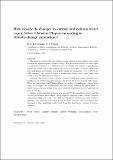How closely do changes in surface and column water vapor follow Clausius-Clapeyron scaling in climate change simulations?
Author(s)
O'Gorman, Paul Ambrose; Muller, Caroline
Downloadogorman_muller_feb_2010.pdf (433.1Kb)
OPEN_ACCESS_POLICY
Open Access Policy
Creative Commons Attribution-Noncommercial-Share Alike
Terms of use
Metadata
Show full item recordAbstract
The factors governing the rate of change in the amount of atmospheric water vapor are analyzed in simulations of climate change. The global-mean amount of water vapor is estimated to increase at a differential rate of 7.3% K[superscript − 1] with respect to global-mean surface air temperature in the multi-model mean. Larger rates of change result if the fractional change is evaluated over a finite change in temperature (e.g., 8.2% K [superscript − 1] for a 3 K warming), and rates of change of zonal-mean column water vapor range from 6 to 12% K [superscript − 1] depending on latitude.
Clausius–Clapeyron scaling is directly evaluated using an invariant distribution of monthly-mean relative humidity, giving a rate of 7.4% K − 1 for global-mean water vapor. There are deviations from Clausius–Clapeyron scaling of zonal-mean column water vapor in the tropics and mid-latitudes, but they largely cancel in the global mean. A purely thermodynamic scaling based on a saturated troposphere gives a higher global rate of 7.9% K [superscript − 1].
Surface specific humidity increases at a rate of 5.7% K [superscript − 1], considerably lower than the rate for global-mean water vapor. Surface specific humidity closely follows Clausius–Clapeyron scaling over ocean. But there are widespread decreases in surface relative humidity over land (by more than 1% K − 1 in many regions), and it is argued that decreases of this magnitude could result from the land/ocean contrast in surface warming.
Date issued
2010-04Department
Massachusetts Institute of Technology. Department of Earth, Atmospheric, and Planetary SciencesJournal
Environmental Research Letters
Publisher
IOP Publishing
Citation
P A O'Gorman and C J Muller. "How closely do changes in surface and column water vapor follow Clausius-Clapeyron scaling in climate change simulations?." Environ. Res. Lett. 5.2 (2010): 025207.
Version: Author's final manuscript
ISSN
1748-9326